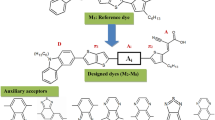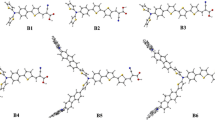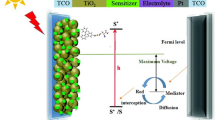Abstract
A series of novel organic dyes (ICZA1, ICZA2, ICZA3, ICZA4) with D-π-A structural configuration incorporating indolo[3,2,1-jk]carbazole moiety as donor (D) unit, thiophene as π-linker and 2-cyanoacrylic acid as acceptor unit were investigated using density functional theory (DFT) and time-dependent DFT (TD-DFT) methods. Indolo[3,2,1-jk]carbazole-based D-π-A dyes composed of different acceptor groups were designed. By modulating acceptor unit, the efficiency of D-π-A dye-based dye-sensitized solar cells (DSSCs) can be further improved. In the present work, four novel push-pull organic dyes only differing in electron acceptor, have been designed based on the experimental literature value of IC-2. In order to further improve the light harvesting capability of indolo[3,2,1-jk]carbazole dyes, the acceptor influence on the dye performance were examined. The NLO property of the designed dye molecules can be derived as polarizability and hyperpolarizability. The calculated value of ICZA2 dye is the best candidate for NLO properties. Furthermore, the designed organic dyes exhibit good photovoltaic performance of charge transfer characteristics, driving force of electron injection, dye regeneration, global reactivity, and light harvesting efficiency (LHE). From the calculated value of ICZA4 dye, it has been identified as a good candidate for DSSCs applications. Finally, it is concluded that the both ICZA2 and ICZA4 dyes theoretically agrees well with the experimental value of IC-2 dye. Hence, the dyes ICZA2 and ICZA4 can serve as an excellent electron withdrawing groups for NLO and DSSCs applications.






Similar content being viewed by others
References
O’Regan B, Gratzel M (1991) A low-cost, high-efficiency solar cell based on dye-sensitized colloidal TiO2 films. Nature 353:737–740
Feng J, Jiao Y, Ma W, Nazeeruddin MK, Grätzel M, Meng S (2013) First principles design of dye molecules with ullazine donor for dye sensitized solar cells. J Phys Chem C 117:3772–3778
Nazeeruddin MK, De Angelis F, Fantacci S, Selloni A, Viscardi G, Liska P, Ito S, Takeru B, Gr¨atzel M (2005) Combined experimental and DFT-TDDFT computational study of photoelectrochemical cell ruthenium sensitizers. J Am Chem Soc 127:16835–16847
Yella A, Lee HW, Tsao HN, Yi C, Chandiran AK, Nazeeruddin MKE, Diau WG, Yeh CY, Zakeeruddin SM, Grätzel M (2011) Porphyrin-sensitized solar cells with cobalt (II/III)–based redox electrolyte exceed 12 percent efficiency. Science 334:629–634
Burschka J, Pellet N, Moon SJ, Humphry-Baker R, Gao P, Nazeeruddin MK, Grätzel M (2013) Sequential deposition as a route to high-performance perovskite-sensitized solar cells. Nature 499:316–319
Liu M, Johnston MB, Snaith HJ (2013) Efficient planar heterojunction perovskite solar cells by vapour deposition. Nature 501:395–398
Li H, Koh TM, Hagfeldt A, Grätzel M, Mhaisalkar SG, Grimsdale AC (2013) New donor–π–acceptor sensitizers containing 5H-[1, 2, 5] thiadiazolo [3, 4-f] isoindole-5, 7 (6H)-dione and 6 H-pyrrolo [3, 4-g] quinoxaline-6, 8 (7 H)-dione units. Chem Commun 49:2409–2411
Yao Z, Wu H, Li Y, Wang J, Zhang J, Zhang M, Wang P (2015) Dithienopicenocarbazole as the kernel module of low-energy-gap organic dyes for efficient conversion of sunlight to electricity. Energy Environ Sci 8:3192–3197
Kar S, Roy JK, Leszczynski J (2017) In silico designing of power conversion efficient organic lead dyes for solar cells using todays innovative approaches to assure renewable energy for future. NPJ Computational Materials 3:1
Seo KD, Song HM, Lee MJ, Pastore M, Anselmi C, De Angelis F, Kim HK (2011) Coumarin dyes containing low-band-gap chromophores for dye-sensitized solar cells. Dyes Pigments 90:304–310
Han L, Wu H, Cui Y, Zu X, Ye Q, Gao J (2014) Synthesis and density functional theory study of novel coumarin-type dyes for dye sensitized solar cells. J Photochem Photobio A 290:54–62
Hara K, Kurashige M, Ito S, Shinpo A, Suga S, Sayama K, Arakawa H (2003) Novel polyene dyes for highly efficient dye-sensitized solar cells. Chem Commun 2:252–253
Rudolph M, Yoshida T, Miura H, Schlettwein D (2014) Improvement of light harvesting by addition of a long-wavelength absorber in dye-sensitized solar cells based on ZnO and indoline dyes. J Phys Chem C 119:1298–1311
Sobuś J, Karolczak J, Komar D, Anta JA, Ziółek M (2015) Transient states and the role of excited state self-quenching of indoline dyes in complete dye-sensitized solar cells. Dyes Pigments 113:692–701
Prakasam M, Anbarasan PM (2016) Second order hyperpolarizability of triphenylamine based organic sensitizers: a first principle theoretical study. RSC Adv 6:75242–75250
Wang ZS, Koumura N, Cui Y, Miyashita M, Mori S, Hara K (2009) Exploitation of ionic liquid electrolyte for dye-sensitized solar cells by molecular modification of organic-dye sensitizers. Chem Mater 21:2810–2816
Chen R, Yang X, Tian H, Sun L (2007) Tetrahydroquinoline dyes with different spacers for organic dye-sensitized solar cells. J Photochem Photobiol A Chem 189(2):295–300
Tian H, Yang X, Chen R, Pan Y, Li L, Hagfeldt A, Sun L (2007) Phenothiazine derivatives for efficient organic dye-sensitized solar cells. Chem Commun 36:3741–3743
Tian H, Yang X, Chen R, Zhang R, Hagfeldt A, Sun L (2008) Effect of different dye baths and dye-structures on the performance of dye-sensitized solar cells based on triphenylamine dyes. J Phys Chem C 112:11023–11033
Kitamura T, Ikeda M, Shigaki K, Inoue T, Anderson NA, Ai X, Lian TQ, Yanagida S (2004) Phenyl-conjugated oligoene sensitizers for TiO2 solar cells. Chem Mater 16:1806–1812
Liang M, Chen J (2013) Arylamine organic dyes for dye-sensitized solar cells. Chem Soc Rev 42:3453–3488
Ooyama Y, Harima Y (2012) Photophysical and electrochemical properties, and molecular structures of organic dyes for dye-sensitized solar cells. Chem Phys Chem 13:4032–4080
Mishra A, Fischer MKR, Bäuerle P (2009) Metal-free organic dyes for dye-sensitized solar cells: from structure: property relationships to design rules. Angew Chem Int Ed 48:2474–2499
Mohr T, Aroulmoji V, Ravindran RS, Müller M, Ranjitha S, Rajarajan G, Anbarasan PM (2015) DFT and TD-DFT study on geometries, electronic structures and electronic absorption of some metal free dye sensitizers for dye sensitized solar cells. Spectrochimica Acta Part A: Mol Biomol Spect 135:1066–1073
Luo C, Bi W, Deng S, Zhang J, Chen S, Li B, Chu J (2014) Indolo [3, 2, 1-jk] carbazole derivatives-sensitized solar cells: effect of π-bridges on the performance of cells. J Phys Chem C 118:14211–14217
Ganesan P, Rajadurai VS, Sivanadanam J, Ponnambalam V, Rajalingam R (2013) Effect of electron withdrawing anchoring groups on the optoelectronic properties of pyrene sensitizers and their interaction with TiO2: a combined experimental and theoretical approach. J Photochem and Photobio A: Chem 271:31–44
Klimeš J, Michaelides A (2012) Perspective: advances and challenges in treating Van der Waals dispersion forces in density functional theory. J Chem Phys 137:120901
Ruiz VG, Liu W, Zojer E, Scheffler M, Tkatchenko A (2012) Density-functional theory with screened Van der Waals interactions for the modeling of hybrid inorganic-organic systems. Phys Rev Lett 108:146103
Hertwig RH, Koch W (1997) On the parameterization of the local correlation functional. What is Becke-3-Lyp? Chem Phys Lett 268:345–351
Yanai T, Tew DP, Handy NC (2004) A new hybrid exchange–correlation functional using the Coulomb-attenuating method (CAM-B3LYP). Chem Phy Let 393:51–57
Chai JD, Head-Gordon M (2008) Long-range corrected hybrid density functionals with damped atom-atom dispersion corrections. Phys Chem Chem Phys 10:6615–6620
Barone V, Cossi M (1998) Quantum calculation of molecular energies and energy gradients in solution by a conductor solvent model. J Phys Chem A 102:1995–2001
Frisch MJ, Trucks GW, Schlegel HB, Scuseria GE, Robb MA, Cheeseman JR, Scalmani G, Barone V, Mennucci B, Petersson GA, Nakatsuji H, Caricato M, Li X, Hratchian HP, Izmaylov AF, Bloino J, Zheng G, Sonnenberg JL, Hada M, Ehara M, Toyota K, Fukuda R, Hasegawa J, Ishida M, Nakajima T, Honda Y, Kitao O, Nakai H, Vreven T, Montgomery JA Jr, Peralta JE, Ogliaro F, Bearpark MJ, Heyd J, Brothers EN, Kudin KN, Staroverov VN, Kobayashi R, Normand J, Raghavachari K, Rendell AP, Burant JC, Iyengar SS, Tomasi J, Cossi M Rega N, Millam NJ, Klene M, Knox JE, Cross JB, Bakken V, Adamo C, Jaramillo J, Gomperts R, Stratmann RE, Yazyev O, Austin, AJ, Cammi R, Pomelli C, Ochterski JW, Martin RL, Morokuma K, Zakrzewski VG, Voth GA, Salvador P, Dannenberg JJ, Dapprich S, Daniels AD, Farkas Ö, Foresman JB, Ortiz JV, Cioslowski J, Fox DJ (2009) Gaussian 09, revision A.1. Gaussian, Inc., Wallingford
O'boyle NM, Tenderholt AL, Langner KM (2008) Cclib: a library for package-independent computational chemistry algorithms. J Comput Chem 29:839–845
Hodge PA, Power GA, Rabjohns M (1997) Synthesis of poly(anthracene-2,6-diyl) and a copolymer containing alternately anthracene-2,6-diyl and p-phenylene units. Chem Commun 1:73–74
Jungsuttiwong S, Tarsang R, Sudyoadsuk T, Promarak V, Khongpracha P, Namuangruk S (2013) Theoretical study on novel double donor-based dyes used in high efficient dye-sensitized solar cells: the application of td-dft study to the electron injection process. Org Electron 14:711–722
He J, Wu W, Hua J, Jiang Y, Qu S, Li J, Tian H (2011) Bithiazole-bridged dyes for dye-sensitized solar cells with high open circuit voltage performance. J Mater Chem 21:6054–6062
Mathew S, Imahori H (2011) Tunable, strongly-donating perylene photosensitizers for dye-sensitized solar cells. J Mater Chem 21:7166–7174
Fitri A, Benjelloun AT, Benzakour M, McHarfi M, Hamidi M, Bouachrine M (2014) Theoretical investigation of new thiazolothiazole-based D-Pi-a organic dyes for efficient dye-sensitized solar cell. Spectrochim Acta Part A 124:646–654
Parr RG, Szentpaly LV, Liu S (1999) Electrophilicity index. J Am Chem Soc 121:1922–1924
Happ B, Winter A, Hager MD, Schubert U (2012) Photogenerated avenues in macromolecules containing Re (I), Ru (II), Os (II), and Ir (III) metal complexes of pyridine-based ligands. Chem Soc Rev 41:2222–2255
Chattaraj PK, Maiti B, Sarkar U (2003) Philicity: a unified treatment of chemical reactivity and selectivity. J Phys Chem A 107:4973–4975
Koopmans T (1933) Ordering of wave functions and eigenenergies to the individual electrons of an atom. Physica 1:104–113
Senthilkumar P, Nithya C, Anbarasan PM (2014) Quantum chemical investigations on the effect of dodecyloxy chromophore in 4-amino stilbene sensitizer for DSSCs. Spectrochimica Acta Part A: Mol Biomol Spec 122:15–21
Janjua MRSA, Khan MU, Bashir B, Iqbal MA, Song Y, Naqvi SAR, Khan ZA (2012) Effect of π-conjugation spacer (C C) on the first hyperpolarizabilities of polymeric chain containing polyoxometalate cluster as a side-chain pendant: a DFT study. Comput Theor Chem 994:34–40
Arivazhagan M, Jeyavijayan S (2011) Vibrational spectroscopic, first-order hyperpolarizability and HOMO, LUMO studies of 1,2-dichloro-4-nitrobenzene based on Hartree–Fock and DFT calculations. Spectrochim Acta A 79:376–383
Peach MJ, Benfield P, Helgaker T, Tozer DJ (2008) Excitation energies in density functional theory: an evaluation and a diagnostic test. J Chem Phys 128:044118
Chattopadhyay D, Lastella S, Kim S, Papadimitrakopoulos F (2002) Length separation of zwitterion-functionalized single wall carbon nanotubes by GPC. J Am Chem Soc 124:728–729
Marinado T, Nonomura K, Nissfolk J, Karlsson MK, Hagberg DP, Sun L, Hagfeldt A (2009) How the nature of triphenylamine-polyene dyes in dye-sensitized solar cells affects the open-circuit voltage and electron lifetimes. Langmuir 26:2592–2598
Rühle S, Greenshtein M, Chen SG, Merson A, Pizem H, Sukenik CS, Zaban A (2005) Molecular adjustment of the electronic properties of nanoporous electrodes in dye-sensitized solar cells. J Phys Chem B 109:18907–18913
Chen SL, Yang LN, Li ZS (2013) How to design more efficient organic dyes for dye-sensitized solar cells? Adding more sp2-hybridized nitrogen in the triphenylamine donor. J Power Sources 223:86–93
Katoh R, Furube A, Yoshihara T, Hara K, Fujihashi G, Takano S, Tachiya M (2004) Efficiencies of electron injection from excited N3 dye into nanocrystalline semiconductor (ZrO2, TiO2, ZnO, Nb2O5, SnO2, In2O3) films. J Phys Chem B 108:4818–4822
Preat J, Jacquemin D, Michaux C, Perpète EA (2010) Improvement of the efficiency of thiophene-bridged compounds for dye-sensitized solar cells. Chem Phys 376:56–68
Zhang J, Kan YH, Li HB, Geng Y, Wu Y, Su ZM (2012) How to design proper π-spacer order of the D-π-A dyes for DSSCs? A density functional response. Dyes Pigments 95:313–321
Ding WL, Wang DM, Geng ZY, Zhao XL, Xu WB (2013) Density functional theory characterization and verification of high-performance indoline dyes with D–A–π–A architecture for dye-sensitized solar cells. Dyes Pigments 98:125–135
Islam A, Sugihara H, Arakawa H (2003) Molecular design of ruthenium (II) polypyridyl photosensitizers for efficient nanocrystalline TiO2 solar cells. J Photochem Photobiol A 158:131–138
Daeneke T, Mozer AJ, Uemura Y, Makuta S, Fekete M, Tachibana Y, Spiccia L (2012) Dye regeneration kinetics in dye-sensitized solar cells. J Am Chem Soc 134:16925–16928
Robson KCD, Hu K, Meyer GJ, Berlinguette CP (2013) Atomic level resolution of dye regeneration in the dye-sensitized solar cell. J Am Chem Soc 135:1961–1971
Acknowledgements
The authors are thankful to the learned referees for their useful and critical comments, which can improve the quality of the manuscript.
Author information
Authors and Affiliations
Corresponding author
Ethics declarations
Conflict of interest
The authors declared that they have no conflict of interest.
Additional information
Highlights
• Four novel indolo[3,2,1-jk]carbazole-based dyes are designed by modifying electron acceptor.
• The lower Eg and larger absorption spectra will favors to light harvesting process.
• The better ICZA2-ICZA4 electron acceptor can be ascribed to enhanced LHE compare to IC-2.
Electronic supplementary material
ESM 1
(DOC 409 kb)
Rights and permissions
About this article
Cite this article
Ammasi, A., Ponnusamy Munusamy, A. Highly efficient organic indolocarbazole dye in different acceptor units for optoelectronic applications—a first principle study. Struct Chem 29, 967–976 (2018). https://doi.org/10.1007/s11224-018-1073-9
Received:
Accepted:
Published:
Issue Date:
DOI: https://doi.org/10.1007/s11224-018-1073-9




